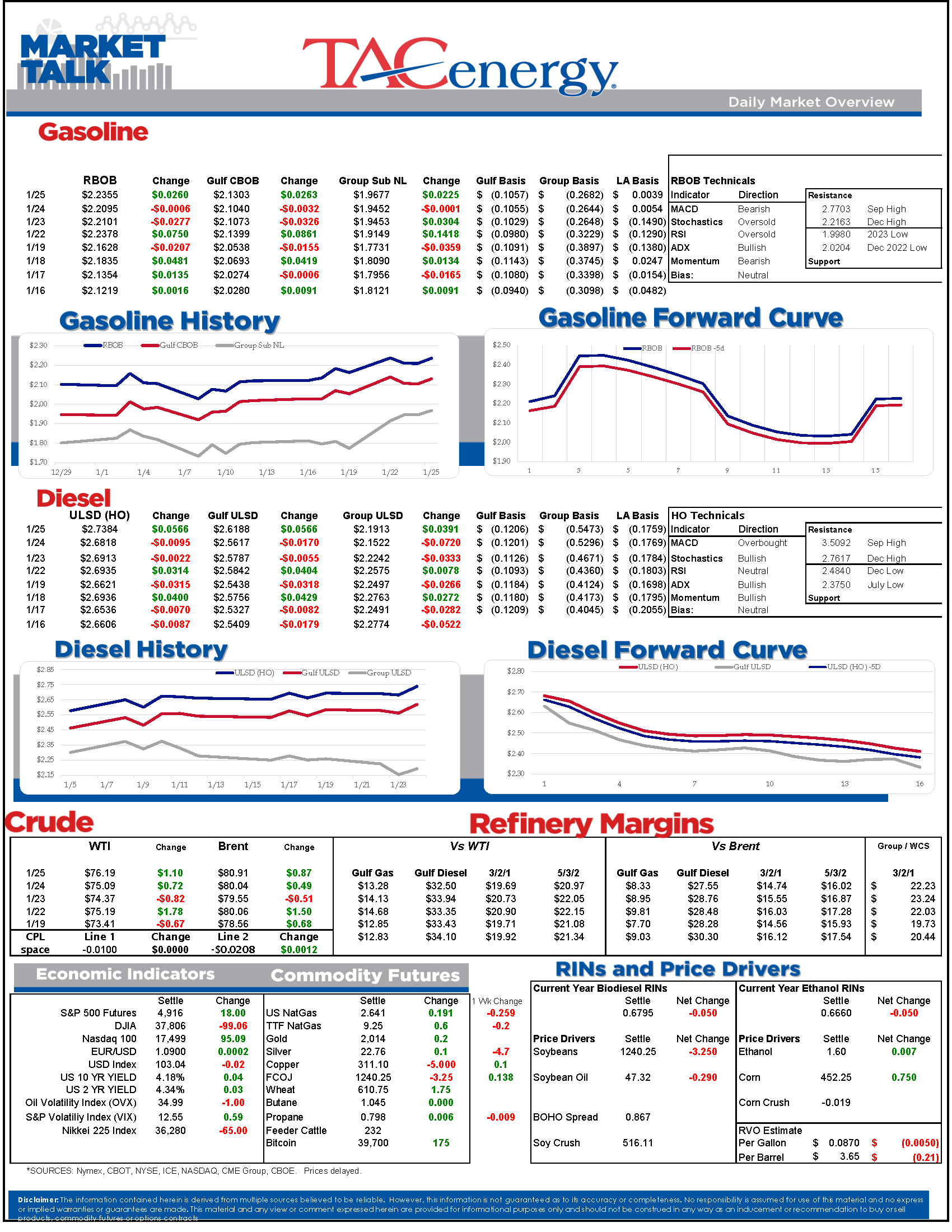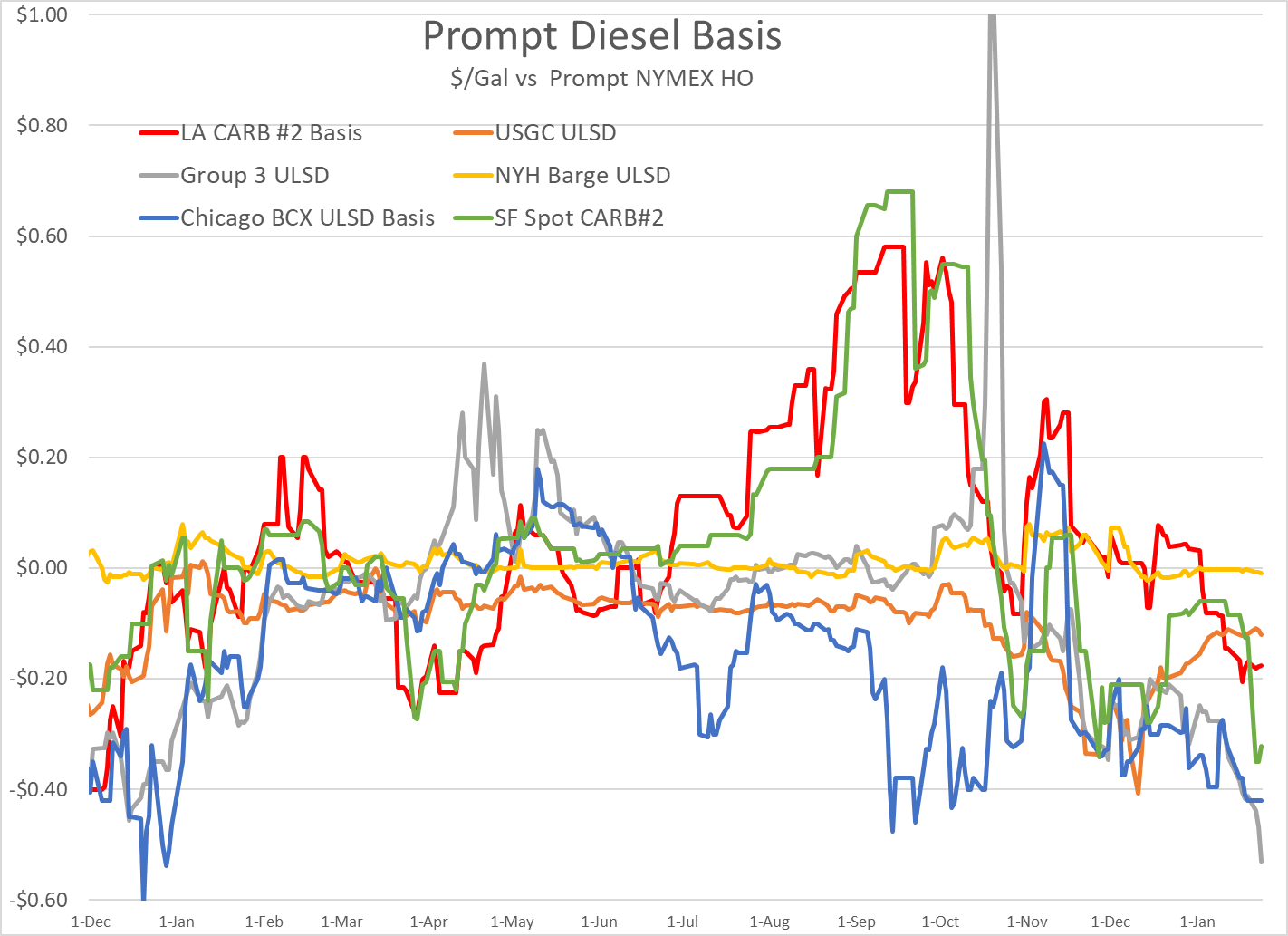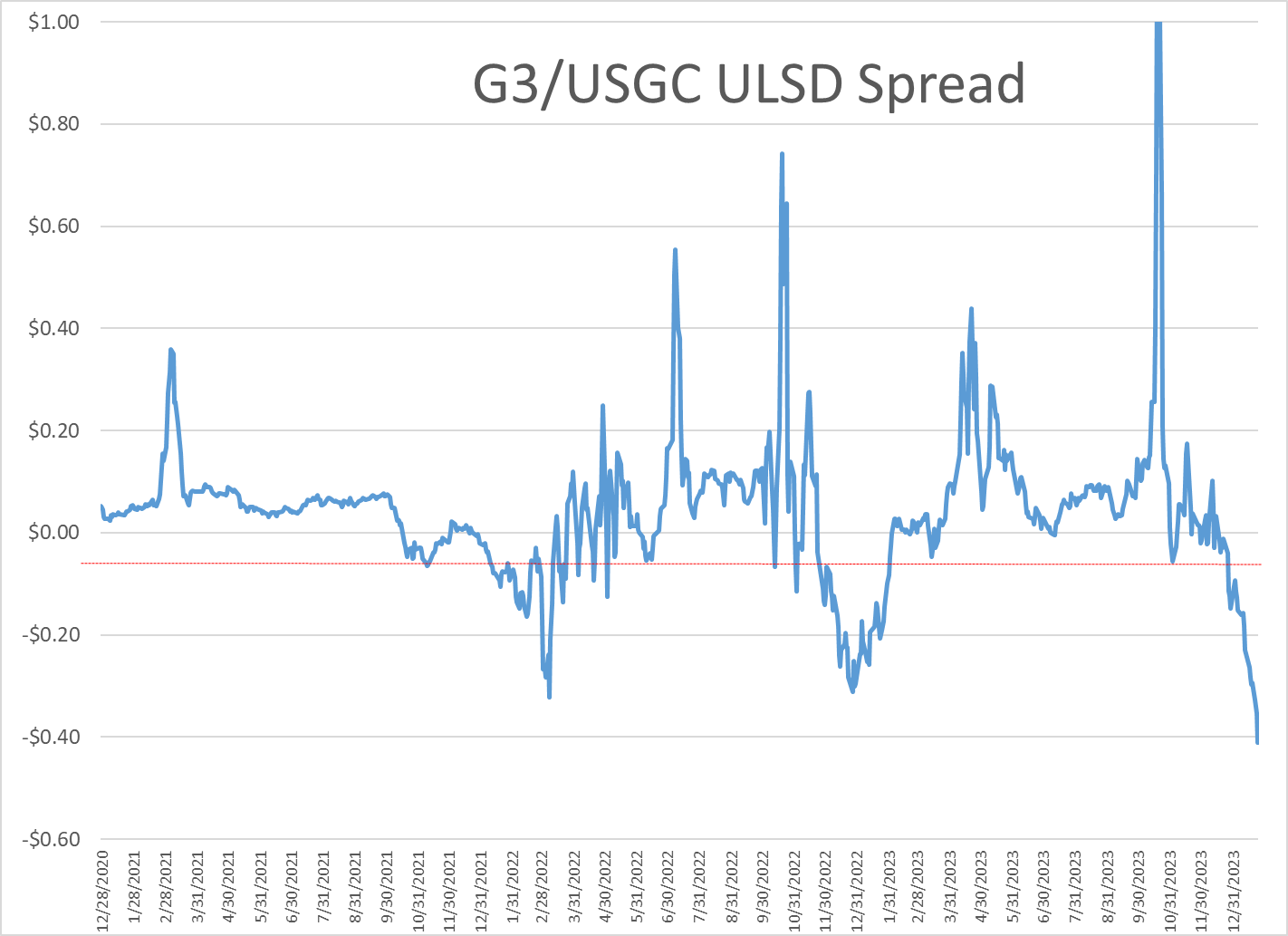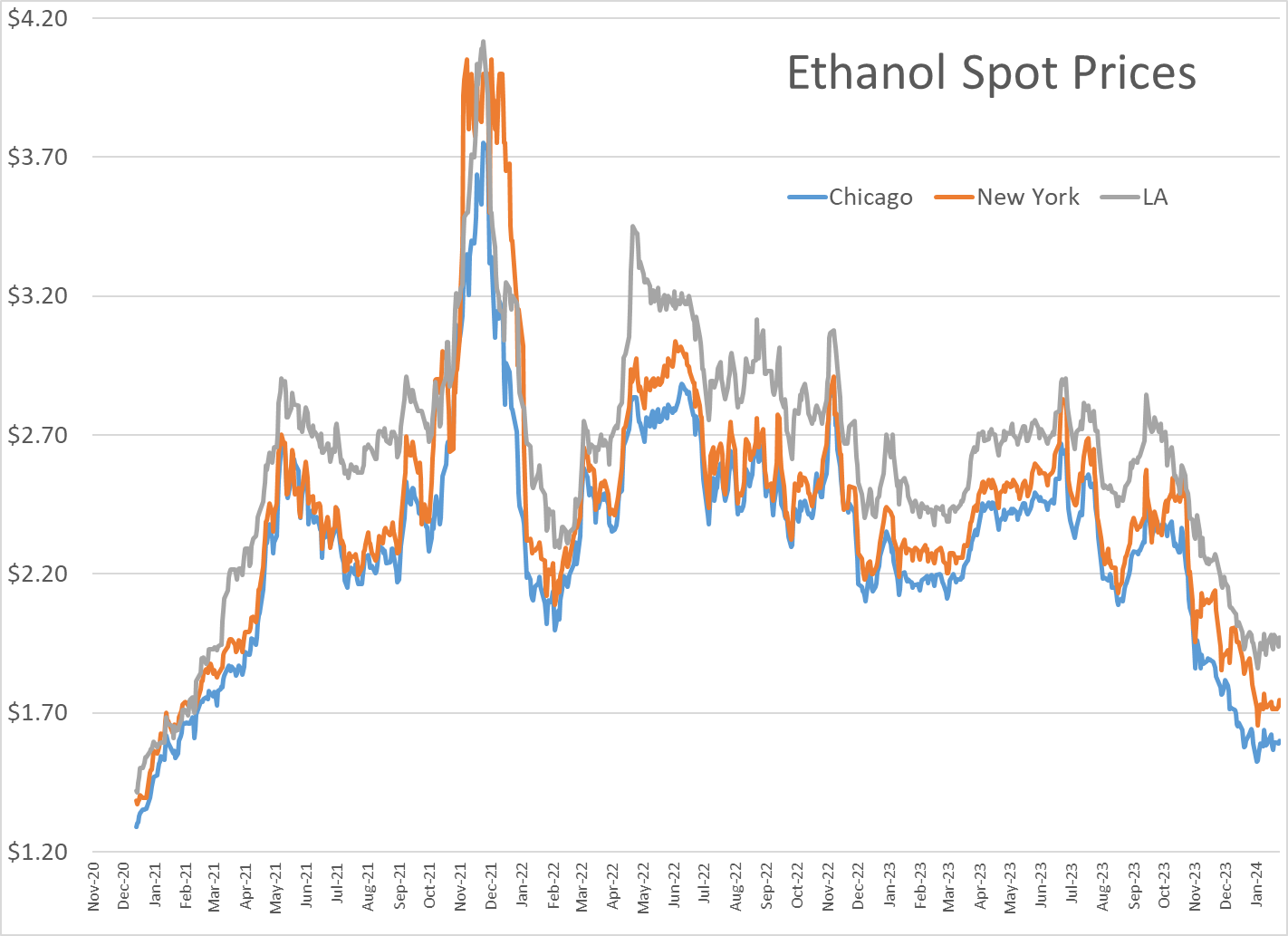Energy Futures Are Off To A Strong Start Thursday, With ULSD Leading The Push Higher Trading Up Nearly 6 Cents In The Early Going

Energy futures are off to a strong start Thursday, with ULSD leading the push higher trading up nearly 6 cents in the early going vs 3 cent gains for RBOB. Despite being stuck in the midst of the winter demand doldrums, and plenty of morning head-fakes early in the year, both ULSD and RBOB futures are looking bullish on the charts, with a strong spring rally looking possible IF they can hang on to their current gains and press through the high end of their winter range this week.
As expected, last week’s storms had a noticeable impact on refinery runs across the middle of the country with PADDs 2 and 3 accounting for roughly 1 million barrels/day of declines. We also get to see why cash markets around the country have been unimpressed by the refinery run reductions as despite the cold snap, refiners are still producing at about the same rate as they were the past 2 years at this time, and since most facilities are already getting back to normal operations, the supply overhang in many regions looks set to continue near term.
That excess is most notable in distillate markets, where for the first time in nearly 14 months all 6 of the major US spot markets have prompt ULSD differentials trading at a discount to prompt HO futures. The Group 3 market is getting the worst of it at the moment, falling to a 50-cent discount to futures Wednesday, knocking $20/barrel off of the diesel crack for local refiners. The 40-cent discount to USGC prices has flipped some inland rack markets like DFW on their head as those with trucks can take the trip north to Oklahoma to save $3-4k per load.
It wasn’t just oil refineries that felt the impact of the cold weather last week. US ethanol production dropped by more than 20% on the week as facilities across the middle of the country struggled with Winter’s wrath. Ethanol prices continue to hold near 3-year lows despite the drop in output suggesting that production won’t stay offline for long.
Oil production also took a million barrel/day hit last week as wells froze in parts of the country, most notably North Dakota’s Bakken fields. State officials estimate it will take 3 more weeks to bring most wells back online, but increased imports from Canada seem to be enough to eliminate any fears of shortages during the downtime.
Valero led off the Q4 earnings releases for major refiners this morning with the expected decline in margins due to rapidly shrinking crack spreads after 2 phenomenal years. The traditional refining segment saw earnings of $1.6 billion, vs $4.3 billion in Q4 of 2022. The company’s RD earnings were slashed by 2/3’s despite (or perhaps because of) volumes increasing by roughly 50% during the year. One bright spot came from the company’s ethanol facilities that earned nearly $190 million, up from close to break-even a year ago as lower corn prices more than offset the drop in ethanol values. The company also noted its SAF project at its Port Arthur RD facility was on pace to be completed Q1 of 2025, which could convert half of its current RD production to SAF and would go a long way to help clear the glut of RD being experienced in some west coast markets.
News & Views
View All
Week 18 - US DOE Inventory Recap

Crude Oil, Gasoline, And Diesel Benchmarks Are All Trading >1% Lower To Start The Day
Energy prices are sinking again this morning, albeit with a little more conviction than yesterday’s lackadaisical wilting. Crude oil, gasoline, and diesel benchmarks are all trading >1% lower to start the day with headlines pointing to an across-the-board build in national inventories as the source for this morning’s bearish sentiment. The Department of Energy’s official report is due out at its regular time this morning (9:30am CDT).
WTI has broken below its 100-day moving average this morning as it fleshed out the downward trend that began early last month. While crossing this technical threshold may not be significant in and of itself (it happened multiple times back in February), the fact that it coincides with the weekly and monthly charts also breaking below a handful of their respective moving averages paints a pretty bearish picture in the short term. The door is open for prices to drop down to $75 per barrel in the next couple weeks.
Shortly after the EIA’s weekly data showed U.S. commercial crude inventories surpassing 2023 levels for the first time this year, their monthly short-term energy outlook is forecasting a fall back to the bottom end of the 5-year range by August due to increasing refinery runs over the period. However, afterward the administration expects a rise in inventories into 2025, citing continued production increases and loosening global markets hindering the incentive to send those excess barrels overseas. The agency also cut back their average gas and diesel price forecasts for the first time since February with the biggest reductions in the second and third quarter of this year.
The STEO also featured their famed price prediction for WTI, stating with 95% confidence that the price for crude oil will be between $40 and $140 through 2026.
Need a general indication of the global crude oil supply? Most headlines seem to be covering a shortage of a different type of oil, one that we haven’t turned into fuel (yet).
Click here to download a PDF of today's TACenergy Market Talk.

The Perceived Cooling Of Regional Tensions In The Middle East Area Attributing To The Quiet Start To Today’s Trading Session
The energy complex is drifting lower this morning with RBOB futures outpacing its counterparts, trading -.9% lower so far to start the day. The oils (WTI, Brent, heating) are down only .2%-.3% so far this morning.
The perceived cooling of regional tensions in the Middle East area attributing to the quiet start to today’s trading session, despite Israel’s seizure of an important border crossing. A ceasefire/hostage-release agreement was proposed Monday, and accepted by Hamas, but rejected by Israel as they seemingly pushed ahead with their Rafah offensive.
U.S. oil and natural gas production both hit record highs in 2023 and continue to rise in 2024, with oil output currently standing at 13.12 million barrels per day and January 2024 natural gas production slightly exceeding the previous year. With WTI currently changing hands at higher than year-ago levels, this increased production trend is expected to continue despite a decrease in rigs drilling for these resources.
Less than a week after the Senate Budget Committee’s hearing centered on the credibility of big oil’s climate preservation efforts, a major oil company was reported to have sold millions of carbon capture credits, without capturing any carbon. Fraud surrounding government subsidies to push climate-conscious fuel initiatives is nothing new, on a small scale, but it will be interesting to see how much (if any) of the book is thrown at a major refiner.
Today’s interesting read: sourcing hydrogen for refining.
Click here to download a PDF of today's TACenergy Market Talk.




